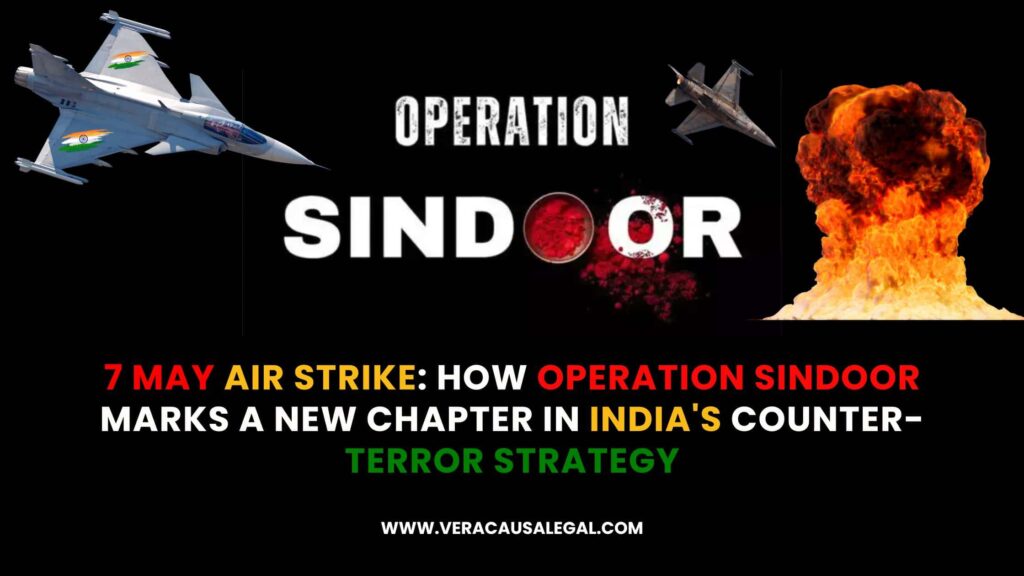In the early hours of May 7, 2025, India unveiled a bold chapter in its counter-terrorism doctrine through Operation Sindoor—a meticulously planned and swiftly executed airstrike targeting terror camps deep within Pakistan and Pakistan-occupied Kashmir. Lasting just 25 minutes, Operation Sindoor was not just a military maneuver—it was a powerful message that India will no longer passively absorb cross-border terror attacks.
The operation was launched in retaliation to the April 22 Pahalgam massacre, where 26 civilians, including tourists, were killed by militants. Operation Sindoor marked a strategic shift: precision, speed, and symbolism blended into one decisive strike.
The Catalyst: April 22 Pahalgam Attack
The picturesque region of Pahalgam in Jammu & Kashmir witnessed one of the most horrific terror assaults in recent memory when militants ambushed Indian tourists. The attack, which claimed 26 lives and injured dozens more, provoked widespread public outrage and an immediate escalation in national security protocols.
Indian intelligence agencies swiftly identified the perpetrators and traced the logistical support to terror infrastructures located across the border—triggering the planning phase for Operation Sindoor.
Why the Name “Operation Sindoor”?
The name Operation Sindoor carries deep emotional and cultural significance. It is rooted in the symbolic weight of sindoor—the red vermilion powder worn by Hindu married women. The April 22 attack specifically targeted Hindu men, leaving countless women widowed and symbolically erasing the sindoor from their lives.
By naming the retaliatory strike Operation Sindoor, the Indian Armed Forces honored the victims and their families, making it clear that the nation will strike back when its cultural and human sanctity is violated. Operation Sindoor thus became both a tribute and a threat—a declaration that such brutality will invite swift retribution.
Execution: A 25-Minute Strike with Strategic Precision
Operation Sindoor began between 01:05 AM and 01:30 AM IST, targeting nine high-value terror locations across Pakistan and Pakistan-administered Kashmir. Among the primary targets were:
- Bahawalpur – Base of Jaish-e-Mohammed.
- Muridke – Lashkar-e-Taiba headquarters.
- Kotli and Muzaffarabad – Terror hubs with strategic infrastructure.
These targets were hit using 24 precision-guided missiles launched by elite Indian Air Force squadrons flying Rafale fighter jets, with support from real-time surveillance drones and intelligence teams.
During the press briefing, Col. Sofiya Qureshi confirmed:
“The terror camp where Kasab and Headley trained has been successfully destroyed. This is a message to every hostile force that India won’t hesitate to defend its people.”
Who Carried Out Operation Sindoor?
The Indian Air Force led Operation Sindoor, with full coordination from ground intelligence, strategic command units, and civil defense forces. The goal: neutralize terrorists with maximum precision and minimal collateral damage.
Guided missiles and real-time intel ensured that targets were neutralized effectively. Every aspect of Operation Sindoor underscored India’s shift from reactive to proactive defense.
Ground Readiness: Protecting the Homeland
In anticipation of potential escalation, India conducted pre-emptive civil security drills in Punjab, Rajasthan, and Jammu. Emergency response teams were activated, air defense systems were deployed, and shelters were readied.
The National Security Advisor emphasized that the protection of civilians was a core part of Operation Sindoor, and all measures were taken to minimize any risk to non-combatants.
Aftermath: Casualties and Conflicting Claims
According to Indian defense sources, around 70 militants and top handlers were eliminated in Operation Sindoor. Pakistan, however, alleged civilian casualties, claiming that 26 civilians were killed and five Indian jets were downed—claims that remain unverified by Indian authorities.
Tensions along the Line of Control (LoC) have since escalated, with reports of shelling, injuries, and evacuations. Yet, India has maintained its position that Operation Sindoor was a necessary and proportionate response under international law.
Diplomatic Ripples: Global Reaction to Operation Sindoor
The global community, including the UN, US, Russia, France, China, and the UK, expressed concern over rising tensions between two nuclear-armed states. While India asserted that Operation Sindoor was a legitimate act of self-defense, international mediators urged de-escalation and a return to diplomacy.
However, the Indian government, represented by Foreign Secretary Vikram Misri, firmly justified Operation Sindoor under Article 51 of the UN Charter.
Strategic Implications: More Than Just Retaliation
What distinguishes Operation Sindoor from previous strikes like the 2016 Surgical Strike and 2019 Balakot Air Strike is its doctrinal evolution. This operation was deeper, quicker, and more targeted—representing a clear policy shift from deterrence to dominance.
India no longer waits for investigations or prolonged diplomatic rounds. With Operation Sindoor, it has adopted a pre-emptive strike model that favors speed and precision.
Unified Response: Civil and Military Resolve
At the New Delhi press conference, top officials including Col. Sofiya Qureshi, Wing Commander Vyomika Singh, and Foreign Secretary Vikram Misri presented a united front:
- Col. Qureshi highlighted the dismantling of known terror hubs.
- Wing Commander Singh affirmed pilot safety and operational success.
- Vikram Misri outlined the international legal basis for the operation.
This synergy between diplomacy, defense, and civil strategy gave Operation Sindoor an air of cohesive national will.
Operation Sindoor: What Lies Ahead?
Operation Sindoor is a strategic inflection point. It signals that India is no longer bound by the old rules of engagement. From intelligence integration to rapid execution, the operation showcases a robust and modern counter-terror doctrine.
More importantly, Operation Sindoor sends a loud message to adversaries and allies alike: India will not be a passive victim of terror. When provoked, it will respond—not just with words, but with firepower and precision.
Conclusion
Operation Sindoor is not just an airstrike. It is a military doctrine, a diplomatic signal, and a cultural statement. It reflects India’s new stance on national security—firm, forward-leaning, and unapologetically aggressive when it comes to protecting its people.
The world is watching. As the dust settles, the legacy of Operation Sindoor will continue to shape how India, and perhaps the world, addresses cross-border terrorism going forward.
For deeper legal insights on national security, international law, and counter-terror policies, visit Vera Causa Legal’s knowledge hub.
